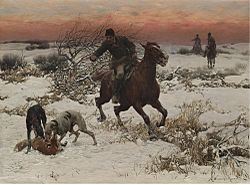Coursing facts for kids
Coursing by humans is the pursuit of game or other animals by dogs—chiefly greyhounds and other sighthounds—catching their prey by speed, running by sight, but not by scent. Coursing was a common hunting technique, practised by the nobility, the landed and wealthy, as well as by commoners with sighthounds and lurchers. In its oldest recorded form in the Western world, as described by Arrian—it was a sport practised by all levels of society, and it remained the case until Carolingian period forest law appropriated hunting grounds, or commons, for the king, the nobility, and other landowners. It then became a formalised competition, specifically on hare in Britain, practised under rules, the Laws of the Leash.
As a zoological term, it refers to predation by running down prey over long distances, as opposed to stalking, in which a stealthy approach is followed by a short burst of sprinting. Humans also employ coursing as a means of hunting, but the term is normally reserved for predation by non-human predators.
Sport and hunting
Animals coursed in hunting and sport include hares, foxes, deer of all sorts, antelope, gazelle, jackals, wolves. Jackrabbits and coyotes are the most common animals coursed in the United States. Competitive coursing in Ireland, the UK (until prohibition in 2004), Portugal and Spain has two dogs running against each other. In the United States, generally speaking, three dogs are run together.
The Protection of Wild Mammals (Scotland) Act and the Hunting Act 2004 (in England and Wales) made it illegal to hunt any type of mammal with dogs with the exception of rabbits and rats. Dogs are still permitted to chase (flush) game into the path of a waiting gun, as long as no more than two dogs are used.
In Australia, dogs may be used to hunt feral animals such as foxes, deer, goats, rabbits, and pigs.
See also
- Greyhound racing
- Cheetah and Caracal – two feline species also historically used in similar hunting practices


